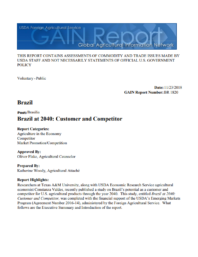
Brazil at 2040: Customer and Competitor

The United States and Brazil have a robust trade relationship. From 2000 through 2017, total two-way trade grew from about $29.2 billion to an average of $74 billion during 2011-14 before falling to $60.7 billion from 2015-2017. An economic downturn in Brazil contributed to the recent decline in trade. U.S. agricultural exports to Brazil have generally grown since 2000, from $264 million to $1.9 billion in 2013 before dropping recently. U.S. agricultural imports from Brazil, many of which are tropical products not produced in the United States, continue to grow and exceed agricultural exports to Brazil by a substantial margin. Brazil is the largest South American market with a population of 207.4 million with growing spending power and imports and an average of $10.5 billion in agricultural and food products per year; however, it is only the 3rd or 4th largest market for U.S. agricultural and food exports to the region as the United States has trade agreements with other South American countries but not with Brazil. Brazil has a trade agreement with other South American countries called MERCOSUL, providing Argentina, Paraguay, and Uruguay agricultural and food exporters with a competitive advantage over U.S. exporters. Brazil via MERCOSUL is also negotiating a trade agreement with the European Union. Brazil also has a combination of taxes and other policies which make imports more expensive. Even with competitive disadvantages, U.S. wheat, cotton, rice, animal feeds, processed foods, eggs, chocolates, and whey exports compete in the Brazilian agricultural and food import market. Many of these and other U.S. exports are predicted to grow over the next several years. Brazil has significant productive capacity in many commodities traded around the world including soybeans, corn, cotton, beef, poultry meat, and orange juice. Brazil is an extremely fierce competitor to the United States in the world markets for soybeans, beef, and poultry meat, and to a lesser extent in corn and cotton. Brazil continues to bring more land into crop production with pastureland being converted as more intensive and integrated livestock production techniques are adopted. As a result, Brazilian soybean production is expected to grow 117 percent by 2040 with exports growing by 120 percent. Brazilian corn and cotton production are both expected to grow by about 80 percent with large increases in exports. Brazilian beef, poultry and pork production are also forecast to grow significantly by 2040. Limiting Brazil’s ability to compete in international markets are poor internal infrastructure and policies which inhibit commerce. Many in Brazil, including private sector coalitions, are working to improve their infrastructure for the more efficient transport of products within the country and to ports. Further, many ports, particularly in northern Brazil, are being upgraded with private investments to handle increased trade. Reforms to Brazilian tax, labor, crop insurance, and environmental regulations could unleash their full competitive capabilities.
- Issues:
- Economics, Natural Resources
- Regions:
- Latin America, North America
- Countries:
- Brazil, United States
- Year Published:
- 2018
- Author:
- Katherine Woody
- Institution:
- USDA Foreign Agriculture Service

